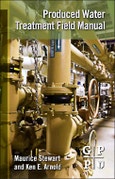Produced Water Treatment Field Manual presents different methods used in produced water treatment systems in the oil and gas industry. Produced water is salty water that is produced as a byproduct along with oil or gas during the treatment. Water is brought along with the oil and gas when these are lifted from the surface. The water is then treated before the discharge or re-injection process. In the introduction, the book discusses the basic terms and concepts that describe produced water treatment. It also presents the different methods involved in the treatment. It further discusses the design, operation, maintenance, and sizing of the produced water treatment systems. In the latter part of the book, the ways to remove impurities in water are discussed, including choosing the proper filter, filtering equipment, filtering methods, and filtering types. The main objective of this book is to provide information about proper water management. Readers who are involved in this field will find this book relevant.
Please Note: This is an On Demand product, delivery may take up to 11 working days after payment has been received.
Table of Contents
Part One: Basic considerations
Chapter One: Pre-treatment considerations
Chapter Two: Upstream equipment considerations
Chapter Three: Process considerations
Part Two: Water treating equipment
Chapter Four: API Separators
Chapter Five: Skimmer Tanks and Vessels
Chapter Six: Plate Separators (Downflow/Upflow/Crossflow)
Chapter Seven: Free-flow Turbulent Coalescers
Chapter Eight: Induced Gas Flotation Units (Mechanical/Hydraulic)
Chapter Nine: Sparger Units
Chapter Ten: Hydrocyclones
Chapter Eleven: Combination Units
Part Three: Information required for design
Part Four: Influent water quality
Part Five: Equipment selection and performance
Part Six: Filtration
Chapter Twelve: Solids removal principles
Chapter Thirteen: Water injection system treatment steps:
Part Seven: Solids removal equipment
Chapter Fourteen: Multimedia Filtration
Chapter Fifteen:Deep-bed Upflow Filters
Chapter Sixteen: Deep-bed Downflow Filters
Chapter Seventeen: Deep-bed Nutshell Filters








